As the country observes commemoration of the terrible 7/7 bombings that occurred in London 10 years ago this day, what will almost certainly be missing from the mainstream coverage is any mention of how flimsy and non-credible the official narrative of those events is.
You will hear constant talk of the ‘four terrorists’ or ‘suicide bombers’ or of the ‘radicalization of British Muslims’. What you won’t hear on any of the major networks’ coverage is any mention of the ‘Terror Drill’ that was going on on the morning of 7/7, any mention of the mysterious white van parked next to the exploded No.30 bus in Tavistock Square, any reference to the mysterious death of 35 year-old Richmal-Marie Oates-Whitehead from New Zealand, any reference to why it was that all of the CCTV for the London Underground on that morning was disabled, or any reference to the fact that it was literally *impossible* for any of the four ‘suicide bombers’ to have actually been on those exploding tube-trains on 7/7.
For anyone who actually examines the facts concerning the events of 7th July 2005, the official narrative remains highly unconvincing.
It can be demonstrated that (1) the four young men could not have been on the tubes we are meant to believe they were, (2) that the CCTV images released of them were fake, and (3) that a staged ‘terror drill’ was going on at exactly the same time and that the drill simulated *precisely* the same scenarios as were played out for real on 7/7.
And of course there’s more; which you will see as you read on. Some of you will already be well-versed in this information, but some of you won’t.
As the July 7th Truth Campaign says on its website, ‘To date, and despite the release of some CCTV footage purporting to be from the day of 7th July 2005, not one piece of evidence has been released to the public that could be legitimately used to convict someone in a court of law for what happened, yet the government still has no plans to organise an Independent Public Inquiry and ‘families of July 7th bombing victims fear they may never learn the truth’.’
Yet of course the way our government and the mainstream media covers the subject, you would mistakenly think that we were dealing with a simple open-and-shut case. The events of 7/7, in which 52 people died and some 700 were badly injured, was the worst terrorist act in Britain since the 1987 Lockerbie Bombing. What’s particularly pertinent about that reference, however, is that the Lockerbie bombing itself is the subject of great controversy, with the official verdict almost certainly a lie concocted in order to justify the decade-long and crippling economic sanctions against Gaddafi’s Libya; which culminated in the 2011 NATO destruction of Libya, in which Britain naturally led the way (and which was based on yet more lies: as explored here).
The events of 7/7 too are highly disputed. The ‘official story’ of July 7th 2005 is that ‘almost simultaneous’ explosions ripped through three London Underground trains, and – just under an hour later – a fourth explosion occurred on a No.30 bus that had been diverted from its normal route. According to the official narrative, we are told that four young men, all British Muslims, had traveled into London to carry out the attack.

These young men were;
- Mohammad Sidique Khan, aged 30, said to have detonated his bomb just after leaving Edgware Road tube station on a train travelling toward Paddington, at 8:50 am. He was from Beeston, Leeds, and had a wife and young child, and had been a mentor in a primary school.
- Shehzad Tanweer, aged 22. Said to have detonated a bomb aboard a train travelling between Liverpool Street station and Aldgate tube station, at 8:50 am. He was also from Leeds.
- Germaine Lindsay, aged 19. Said to have detonated a device on a train travelling between King’s Cross and Russell Square tube stations, at 8:50 am. He lived in Aylesbury, Buckinghamshire, with his pregnant wife and young son.
- And Hasib Hussain, the youngest of the four, aged 18. Hussain is claimed to have detonated a bomb on the top deck of the double-decker, No.30 bus at Tavistock Square, 9:47 am. Square.
The above story, however, doesn’t hold up under scrutiny. And it never did. Let’s highlight some of the main reasons why;
- The train that the mock-terrorists were supposed to catch – the 07.40 am train to Kings Cross – had been cancelled that day (along with the train after that), meaning that *they couldn’t possibly board the tube-trains they were supposed to* for what was almost certainly a training exercise (more on that in a moment). Despite *official confirmation that these trains had been cancelled* that morning, the official Home Office report still insists that the non-existent 07.40 am train was the train the four young men travelled into London on. It is impossible. The first available train the four young men could catch would’ve had them arriving at Kings Cross *after* the tube-trains they were allegedly on had already departed. When the men learn that the tube-trains they were supposed to be on have by now blown up, they of course realise that this is no longer a training exercise but *a real attack* and that they have been set up by their handlers.
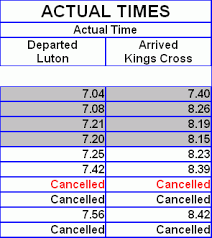
- The initial train operating company reports on the day made no mention of ‘suicide bombers’, but announced that the devastation on the Underground was the result of a “power surge”, and this continued to be reported until shortly after the explosion of a No.30 bus in Tavistock Square at 9.47 am – a bus that had been mysteriously diverted from its normal route to take it to Tavistock Square. The ‘power surge’ reference becomes additionally significant when we look at the murder of the Brazilian electrician Jean Charles de Menezes (more on that later).
- The first train *after* 07.40 am left Luton at 07.56 am and arrived at Kings Cross at 08.42 am. The three tube-trains that exploded left Kings Cross at 08.35 am (Eastbound Circle Line), 08.42 am (Westbound Circle Line) and 08.48 am (Picadilly Line, south). It is therefore simply impossible for any of the four young men to have been on any of those trains that exploded.
- We are told that at 8:49 am, three bombs were supposedly detonated on board London Underground trains within fifty seconds of each other. But it was only on July 9th that the timing of the explosions on the Underground was revised considerably. The blasts’ timings were changed from the original reports and made to have occurred ‘almost simultaneously’ at 8.50 am. Scotland Yard now reported the Underground incidents had occurred within 50 seconds of each other, despite the original timings spaced over 26 minutes. Why did the original stories of power surges, train collisions and derailments with separate times now turn into a story of simultaneous suicide bombs?
- Witnesses from the underground explosions reported that they saw no suspicious ‘Muslim men’ with backpacks on their trains, nor any unattended bags or packages. Many also reported that the explosions *blew upwards from underneath the trains*, suggesting pre-planted explosives and not bombs set off in any of the carriages. Explosives planted under the train would rupture the carriage floors and would be powerful enough to lift the carriage up off the rails – which is precisely what was reported as having happened. Crude, home-made explosives could not have accomplished that effect; what had to have been used were military-grade explosives that wouldn’t have been available to the four young men. The explosives had to have been planted under the tube-train carriage floors – needless to say, only people with privileged access to the underground tunnels could’ve done that.
- At 11.00 am on July 8th, the Metropolitan Police stated that: ‘there is no evidence to suggest that the attacks were the result of suicide bombings although this cannot be ruled out.’
- Fifty seven minutes after the ‘almost simultaneous’ explosions on the underground, an explosion occurred outside the British Medical Association headquarters on a No.30 bus that had been diverted into Tavistock Square. Immediately after the bus explosion, Sky News was ordered to pull its helicopter out of the skies over the area and subsequently very little footage now exists in of the bus in the immediate aftermath of the incident.
- Guardian journalist Mark Honigsbaum, who talked to eyewitnesses at the Edgware Road bombing, described the same process of an *upward explosive force*: eyewitnesses told Honigsbaum that “tiles, the covers on the floor of the train, suddenly flew up, raised up.”
- This is confirmed again: American student Sean Baran was walking towards Edgware Road Station when the explosion occurred. “One gentleman told me that the floor of the train he was on was blown out, it was just gone,” he told Sky News.
- And again, this time by another survivor, Bruce Lait, who was in a tube carriage in which an explosion occurred. He reported that as they made their way out, a policeman pointed out where the bomb had been. “The policeman said ‘mind that hole, that’s where the bomb was’. The metal was pushed upwards as if the bomb was underneath the train. They seem to think the bomb was left in a bag, but I don’t remember anybody being where the bomb was, or any bag,” he said.
- Contrary to popular misconceptions, the exact means used to kill the victims of 7/7 has never been established. The official cause of death in each case is classified as ‘injuries suffered in an explosion’, but the actual specific type of explosives used have never been determined. At the July 7th inquests into the deaths, explosives expert Clifford Todd admitted that they had found no trace of the main explosive at any of the bomb sites. If these were home-made or crude bombs in backpacks and on the carriages, this wouldn’t be the case – there would be traces.
- This view was also taken by other experts. “The nature of the explosives appears to be military, which is very worrying,” said Superintendent Christophe Chaboud, the chief of the French anti-terrorist police, who was in London at the time to assist Scotland Yard.
- Why did the police report there had been six explosions, when they were only four?
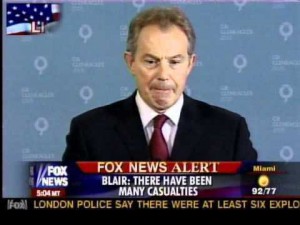
Now we get to the all-important matter of that ‘terror drill’ that just happened to be conducted *exactly at the same time* as the actual attacks occurred. This has become such a cliche that it is in fact the calling-card for false-flag terrorism events. Just as on 9/11 and just as in the later Boston Marathon bombing, a ‘terror drill’ exercise provided the perfect mechanism for a real-world terrorist atrocity to be staged.
- It is at this point that we need to introduce a man named Peter Power, who proves extremely significant to the events of 7/7 (for reasons that will soon be clear). In this interview with Radio 5 Live on the day of 7/7, Mr Power refers to “simultaneous bombs going off”; yet it wasn’t until 9th July, two days after the incidents, that the explosions were starting to be talked about as having been ‘almost simultaneous’. At the time Mr Power was giving this interview, the official line didn’t include any reference to ‘simultaneous bombs going off’.
- Ex-Mossad Chief, Efraim Halevi, also wrote in The Jerusalem Post on 7th July 2005 of “the multiple, simultaneous explosions that took place today on the London transportation system” with “near perfect execution”; again, this was astonishingly prescient, as the ‘simultaneous explosions’ verdict hadn’t been established by the authorities until two days later. Like Mr Power, Mr Halevi seemed to already know something that the investigators did not.
- Peter Power was a ‘Crisis Management Specialist and government adviser’. On 7/7 itself, Peter Power and his company Visor Consultants told the media that they and the unspecified company employing them (who dictated the specific attack scenario to them) had run a mock terror drill on the London Underground. The scenario of the mock terror drill was precisely the same scenario as discussed on the Panorama programme a year earlier (more on that shortly)… and precisely the same scenario that the four so-called suicide-bombers of 7/7 actually appeared to carry out. The unspecified ‘customer’ that dictated the specific scenario for the terror drill was undisclosed by Peter Power. Even Peter Power himself admitted in a later interview that, in terms of the correlation between the staged drill and the actual terrorist attack, “our scenario was identical.”
- On 8th July 2005, the day after the destruction in London, another interview with Peter Power appeared on page 5 of the Manchester Evening News in which Mr Power revealed that, not only had he coincidentally been managing a terror rehearsal ‘based on simultaneous bombs going off precisely at the railway stations where it happened’ on 7th July, but had also organised a series of ‘mock broadcasts’ for the rehearsal operation – and that these were apparently so realistic that those participating in the exercise became (understandably) confused about what was real and what was simulation; just as was the case on 9/11. Power’s pre-planned fictional/drill scenario, as explained by the man himself on the day, bears a closer resemblance to the eventual story of 7/7 than it did to the actual story that had been presented to the public by the police and authorities at the time of his interview. But there is a broader, longer, context to this 7/7 ‘drill’ and to Power’s own involvement.
- On 16th May 2014, one year prior to the 7/7 event, the BBC had broadcast a Panorama program discussing how to deal with a potential terrorist attack on London. The program envisioned three bomb explosions on the London Underground and one on a road vehicle; which, for an apparently speculational TV programme, is extremely (and suspiciously) prescient. Why specifically four explosions? Why not five? Or two? And why specifically three underground bombs and one road-vehicle? Give or take one or two details, the programme can basically be seen as a media dry-run of what would unfold on 7/7. The programme also discussed the planning of tightly-controlled media coverage of the attack and how to script the BBC News response; at one point, ‘taking control’ of the BBC is even discussed. The program included Michael Portillo, Home Secretary David Blunkett and the ever-present Peter Power himself. A copy of the Panorama programme is predictably no longer available from the BBC website; but you can read a transcript of the 2004 Panorama ‘London Under Attack’ programme here.

- The mock drill exercise, it is often claimed, involved some 1,000 people. Among them would of course have to be the actual ‘terrorist’ actors themselves; the mock-bombers recruited to play out the scripted scenario. In actual fact, we don’t know that ‘1,000 people’ were involved; the ‘1,000 people’ Power refers to might have actually been a reference to the number of people in the company he was working for and not actual actors on the ground. However, it may well be that the four young ‘suspects’ had been *told* there would be numerous other ‘actors’ on the underground and in the chosen areas.
- Curiously too, Kirsty Lang, who was the ‘newsreader/actor’ in the mock 2004 Panorama simulation of London Underground terror attacks, was also inexplicably brought in by the BBC to be the real-world newsreader for the actual coverage of the actual 7/7 bombings; despite the fact that she wasn’t one of the regular newsreaders and wouldn’t have been at all a logical choice. Why Lang was brought in to cover 7/7 remains unexplained.
Then there’s there’s the issue of the complete failure of all relevant CCTV;
- All of the CCTV cameras at all four locations where the explosions went off that day were conveniently “not working” on 7/7/2005. Even if we were to believe it was just bad luck that the surveillance for the London Underground was switched off that morning, the security cameras for the No.30 bus that exploded in Tavistock Square are of course completely unrelated to the London Underground CCTV: who but the village idiot would believe that both surveillance systems would’ve been accidentally failing that morning?
- The company responsible for CCTV surveillance on the London Underground is an Israeli firm called Verint Systems. No CCTV footage of the four alleged suicide-bombers has ever been released by Verint Systems. The reason? Verint claim that the cameras were not working that day. There remains, therefore, no proof whatsoever that the four British Muslim men were on the London Underground that day. Another Israeli company, transport security firm ‘ITCS’, has an office close to the Luton train station where the ‘suicide bombers’ set off to London from, and is suspected by some of being where the young men went to receive final instructions. John Hill, in his film Ripple Effect, suggests that this office might’ve been where the men went to confirm details on which trains to board, which carriages to get into, where to sit, which bus to catch and at what time – all under the misapprehension that they were merely taking part in the planned ‘terror drill’.
- An employee of Stagecoach, the company responsible for the majority of London buses, confirmed that the driver of the No.30 bus had pointed out that this bus was the only one to be re-routed after the initial bombs went off in the London Underground: every other bus carried on its normal journey, but for some reason this one bus was diverted. Why? The CCTV on the buses is maintained at least two or three times a week and is able to digitally store up to two weeks worth of surveillance footage (done by a private contractor). So why was the CCTV disabled for that single No.30 bus… which also, again, happened to be the only London bus re-routed that morning?
- And why was the No.30 bus driver, George Paradakis, taken into hiding by the police after the Tavistock explosion? Did they want to keep him quiet? As I said earlier, Mr Paradakis was the father of a family friend of mine: he was so traumatised after the incident that he retired.
- Why did none of the four CCTV cameras in the No.30 bus work on 7/7? Scotland Yard’s explanation that the bus driver might have forgotten to switch them on is nonsense, as according the bus company the cameras are always switched on.
Let’s talk now about the extremely dodgy CCTV images that were released and frequently shown across the media. Estimates about the proliferation of CCTV cameras around the world suggest that something like 20% of all CCTV cameras are located in just the UK, with London having the most: yet, to date, no CCTV images of the four alleged suicide bombers have ever been released showing all four of the accused in London on July 7th 2005. In fact, only one CCTV image has ever been released that purports to show all four of the accused together and it is outside Luton Station, some 30 miles from the scenes of the crimes; and even in this image, three of the four faces are entirely unidentifiable.
There are numerous anomalies regarding the most famous image (the one that purports to show the group). Firstly, it is immediately peculiar that there is only this one still image as opposed to proper moving footage or a sequence of images.
- Initially, only two images had been released, within a couple of days of each other; the first being an extremely (and suspiciously) closely-cropped still-image of 18 year-old Hasib Hussain. There is no explanation offered for why the photo was so ridiculously cropped in the manner shown, nor any explanation of where the other three men are. There is also no explanation for why all/any unique points of reference (that might indicate where the picture was taken) have been edited out of the image. This image of Hasib Hussain is utterly, utterly pointless. It offers no indication of where he is supposed to be nor of when it was taken. There is no time or date stamp. If I was asked to release the most unconvincing, comically inadequate, fake picture as a joke…then this image of Hasib Hussain is what I would’ve come up with.
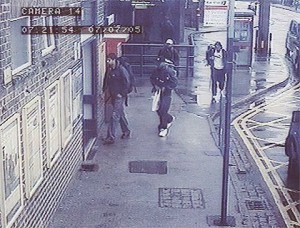
- On September 21st 2005, another supposed piece of CCTV footage was released showing three of the four suspects at both Luton Thameslink station and Kings Cross, taken from June 28th 2005. This footage has repeatedly appeared in news coverage of the events of July 7th (minus the time and date stamps), giving the false impression that it might be footage of the accused on 7/7; but this is precisely how false perceptions are embedded into the viewing public’s consciousness by the corporate/mainstream media. It also shows only three of the men entering Luton station on June 28th 2005.
- More importantly, as is noted by the July 7th Truth Campaign, ‘When the image from July 7th is overlaid with a still from the June 28th footage, even more oddities emerge. Lindsay is carrying exactly the same carrier bag in the same hand in both. Tanweer’s outfit on the 7th appears to be a negative image of what he was wearing on the 28th. Notice also how the kerb stones appear disjointed at the point where the vertical kerb arcs to the right in the image purporting to be from July 7th 2005…’
- This site was one of the first to expose the fraud of the main CCTV image provided by authorities as ‘proof’ of the suicide-bombers. “At first, (almost) everything looks fine, but look closer… look at the guy with the white hat… check out his left arm (HIS left arm)…. the lower of the rails of the railing is IN FRONT of his left arm… where of course it shouldn’t be. This looks ridiculous. I’d say it´s a fake.” It continues, “The white-hatted man was apparently superimposed onto the photo. Not only is his arm ‘behind’ a railing that is supposedly several feet behind HIM, but also, upon magnification in Photoshop, part of the bar actually goes into his head. This was ‘touched-up,’ but pixels of his head mix unmistakably with pixels from the railing. Here is an enhancement of the picture. You can clearly see that the railing appears IN FRONT of the supposed bomber’s left arm. Not only this but there also seems to be a railing running through the man’s head. A further analysis clearly shows the railing continuously running visible through the man’s head.’

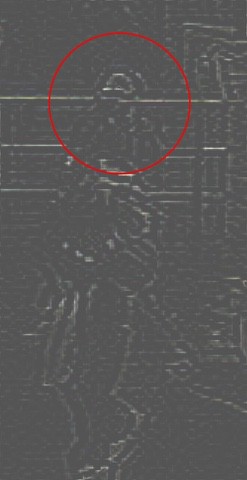
- And from the same analysis of the image; ‘There is also a noticeable outline above the bomber’s cap and around his head, indicating the image has been “cut out” and superimposed onto the original.’
- On October 2nd, three months after the London bombings, another still image was released of Hasib Hussain on his own. He is apparently exiting the Boots store at Kings Cross mainline station. Like the earlier image of him, there is no date or time-stamp on the image. Therefore, this image could have been produced at any time. The media stated that the image was captured at 9.00 am on 7/7 – however, by this time in the morning of 7/7, Kings Cross station was already being evacuated and there were reports of ‘pandemonium’. This picture of Hussain doesn’t depict any of that ‘pandemonium’, but appears to show a very normal environment.
- The complete and utter failure of all of London’s vast CCTV surveillance is bad enough, considering that we do not have even one reliable surveillance recording of the ‘bombers’. But nor did a single eyewitness offer any reliable report of having witnessed any of the four ‘bombers’ on 7/7. No one in Luton, no one on the trains or at the stations in London, no one in or around the No.30 bus, positively identified any of the suspects. The media gave suspiciously quick and excessive screen-time to the demolition expert and sole Tavistock ‘witness’ Richard Jones, (who we will come back to in a moment), yet it is clear that Mr Jones was lying and hadn’t seen Hasib Hussain at all. For one thing, Jones – who claimed to have watched the ‘suspect’ reaching suspiciously into this bag – told the press that he was downstairs on the No.30 bus; but the explosion is claimed to have happened on *the top deck*.
Given therefore that (1) the four young men couldn’t have been on those exploding tube-trains, as they couldn’t have reached Kings Cross in time, and (2) that the only CCTV images of them are fake ones, there is surely enough information already to exonerate them.
But if you’re still unconvinced, let’s continue further.
- All four also carried driver’s licences and ID cards with them to their deaths, which is not logical behaviour for terrorists. One of the ‘bombers’, Germaine Lindsey, who’s car was discovered left in Luton displayed a seven-day parking ticket on its dashboard. It is absolutely clear that these four young men had no intention of dying and that they therefore could not have been ‘suicide bombers’. The four ‘suicide bombers’ were simply training-exercise participants doing a job for which they were expected to be paid and, on another level, doing a patriotic duty by cooperating with security and intelligence organisations in acting out a terror drill for the sake of future protection of British citizens in any possible real-world terrorist attacks.
- If they were suicide-bombers, of course, then they would logically purchase only one-way train tickets in order carry out their mission. We are told, however, that all four young men actually purchased return-tickets. Which makes no sense for an actual terrorist attack; but does of course make sense if they were simply participating in a planned drill.
- No one who knew any of the alleged bombers believed they could be murderers and no one suspected a thing. None of them were known as being particularly political or religious. None of them had a serious criminal record.
- Mohammad Siddique Khan must be the least likely and least convincing ‘terrorist’ or ‘extremist’ to date. The view of Khan as a convert to extremist ideologies or an Al-Qaeda sympathiser was (and remains) entirely contradicted by friends of Khan, who told of how ‘Western’ Khan, known by his Anglicised name of ‘Sid’, considered himself British (and how, returning home from a trip to the USA, was besotted with all things American). Two of Khan’s friends from school were interviewed for a BBC Radio 4 documentary, ‘Biography of a Bomber’. The documentary revealed that Khan’s friends were mostly white English and that he considered himself a Westerner and a ‘proud British Muslim’. Needless to say, he had expressed no extremist views to anyone, and was not known to have been very religious. Mohammad Siddiq Khan was, from all appearances, a law-abiding British Muslim who was befriended by the police and was in fact a pillar of his community.
–

–
- The general and inescapable view of the four ‘bombers’, their backgrounds, and most importantly their behaviour on the morning of 7/7, suggests that they had no intention of dying. One of the ‘bombers’ was filmed arguing with a cashier about being shortchanged hours before he allegedly blew himself up, according to a piece in The Independent. Would a man on a ‘holy’, one-way suicide mission care about being shortchanged in a minor purchase?
- A Metropolitan Police counter-terrorist expert also told a seminar that the four ‘terrorists’ simply did not fit the terrorist profile. The official told a seminar in Preston, Lancashire; “I’ve seen the CCTV footage of these people. They do not appear to be on their way to commit any crime at all.”
- ID cards said to belong to Mohammad Siddique Khan were reported by different news outlets to have been discovered at three of the four explosion sites. How could he have been in all three sites? Plus, as with the 9/11 hijacker passports, how is it that paper documents remarkably survive bomb blasts that otherwise rip apart metal, trains, buildings and people?
- Identity documents to identify Tanweer were also found both at Edgware Road station (where he is supposed to have died) but also at the Aldgate bomb scene. Again, aside from the question of why these ‘suicide bombers’, like the 9/11 hijackers, were carrying ID, how could he have been both at the Aldgate AND Edgware Road bomb sites?
- The youngest of the 7/7 actors, 18 year-old Hasib Hussein, described by those who knew him as “a gentle giant”, was reported to have been seen casually wandering around London streets for well over an hour, even stopping into McDonalds for a burger. He wasn’t thought to be acting suspicious in the least bit, nor acting like someone involved in terrorism. The indications of chaos and panic he might’ve observed in the city would’ve seemed to him, logically, like part of the planned terror drill, since – as far as he would’ve been told beforehand – at least a thousand actors were supposed to be taking part in the London training exercise. As the assigned actor intended to board a pre-arranged bus (and not a tube-train like the others), he may not even have been aware of the underground explosions having happened; it is known that he attempted to use his phone to communicate with the others, but the phones were all being jammed and he therefore had no way of knowing what anyone else’s situation was.
- Hasib Hussain of course ended up as the ‘bomber’ accused of blowing up the No.30 bus in Tavistock Square. There is nothing to suggest he did so, however; all we do know is that – according to the official story – he was killed in the explosion on that bus that he was told to make sure he was on. Note also that the Panorama programme a year earlier had specified Tavistock Square for the location of the single road-vehicle explosion that would accompany the three underground bombs. The Mirror reported that Hasib was ‘full of hate’ from the age of 14 when he ‘threatened terror against classmates’ in the wake of 9/11. However, these claims were utterly rubbished by the headmaster of the school, who painted an entirely different picture of the young Hasib. This again is simply a demonstration of mass media fakery designed to make someone seem ‘more the part’ of the terrorist or the monster.
- A news broadcaster early in the day of 7/7 reported that three of the suspected terrorists had been shot and killed by police near Canary Wharf in the Docklands area of the East End. This announcement was only made once and then of course never repeated: because how could the ‘suicide bombers’ who’d supposedly blown up the London Underground tube-trains later also be shot dead near Canary Wharf? But the Canada Globe and Mail and New Zealand Herald newspapers both, however, reported that the suicide-bombers had been shot dead outside the HSBC building or near Canary Wharf. It can’t be confirmed, of course, that these shootings took place. But if three of the four alleged suicide bombers were shot dead by police near the Docklands – and none of them could’ve possibly been on the tube-trains that actualy blew up (as the London-bound trains that would’ve got them there had been cancelled) – then clearly someone else planted the explosives on the London Underground trains.
- The Herald piece appears to report the shootings as matter-of-fact; ‘A New Zealander working for Reuters in London says two colleagues witnessed the unconfirmed shooting by police of two apparent suicide bombers outside the HSBC tower at Canary Wharf in London. The New Zealander, who did not want to be named, said the killing of the two men wearing bombs happened at 10.30 am on Thursday (London time). Following the shooting, the 8000 workers in the 44-storey tower were told to stay away from windows and remain in the building for at least six hours, the New Zealand man said.’ Where did the New Zealand Herald gets its story from? And why did they report it so matter-of-factly, as if they weren’t worried about the story being later contradicted? Curiously, on July 7th 2003 (exactly two years prior to 7/7), the fifth episode of the BBC Spooks series features an MI5 training exercise that coincides with a real major terrorist attack on London. And along similar lines (and reminiscent of the Lone Gunmen series’ prophetic ‘9/11 episode’), the 2004 made-for-TV movie Dirty War centers on a large-scale emergency exercise and concludes with a real terror attack that perfectly mirrors the scenario for that exercise. The same film also depicts four Muslim suicide bombers attacking London (two of them at Liverpool Street tube station); and it also has two of the suicide bombers being shot dead by police at Canary Wharf.
- Mohammad Siddiq Khan’s famous video would’ve simply been part of the carefully scripted exercise, which, as the chief ‘terrorist’ actor, he would’ve been asked to make. His so-called ‘suicide note’, revealed a very long time after the fact, was almost certainly a fake concocted between intelligence and media agencies, and his young wife, who was clearly the victim of prolonged police harassment and intimidation, simply caved in to pressure eventually and decided to publicly accept the official narrative. In his oft-referenced ‘martyr video’, we should note that there is no mention of any specific intentions he has. He does not refer to the crime he is suspected of perpetrating (7/7), and he doesn’t mention any of the other three, so even if you regard the video as implicating him, it doesn’t implicate the other three. Numerous people, especially those who knew Mr Khan, dismiss the video as fake. Even many of those with no personal interest in Khan are highly suspicious of the video. Khan’s lips appear to be out of sync at times. The video glitches at the start, but yet the audio doesn’t – suggesting that the audio was added in separately. Faking videos, of course, just like faking supposed CCTV images, is fairly easy.
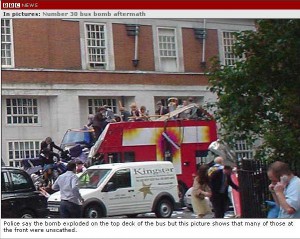
So, there is another very significant element that I might’ve mentioned earlier;
- A white van, clearly identified as belonging to the demolition company ‘Kingstar’ (and pictured above), was photographed next to the exploded No.30 bus in Tavistock Square. Kingstar specialises in controlled demolitions. Richard Jones (the same Richard Jones we talked about earlier), a key witness, claiming to have been *on* the No.30 bus, very quickly gave his account to TV reporters on the morning of 7/7. This seemingly random ‘witness’ was in fact reported by some newspapers, including The Sunday Mail, to have worked in an explosives factory in Ayershire. Further, as John Hill notes in his now famous film Ripple Effect, Richard Jones’ testimony to reporters at different times is so contradictory and inconsistent that it is entirely unbelievable. For one thing, it is noted that Jones claimed he got off the bus one stop before the explosion (as a man who’d planted the explosive might do). Yet in another interview he says he got off because it was his stop – yet the bus he was on had been *diverted* from its normal route, so how could it be “his stop”? Jones’s descriptions of Hasib Hussain were also inconsistent and in some cases even just brazenly inaccurate, suggesting that he never laid eyes on the real Hasib Hussain (or further, that Hasib Hussain was never on the No.30 bus).
- So is it just coincidence that a van belonging to Kingstar – a controlled demolition company – just happened to be pop up right beside the No.30 bus that had for some reason been diverted off its normal course that morning, and which then exploded in Tavistock Square? Also curious is that Kingstar, a British company had, among its various customers, worked for ‘Carillon’ – one of the largest rail engineering firms in the country. One of Carillion’s departments, TPS, has worked previously with the Atomic Weapons Establishment, provider of the UK’s nuclear warheads.
And yet the curiosities and suspicious elements to the story continue;
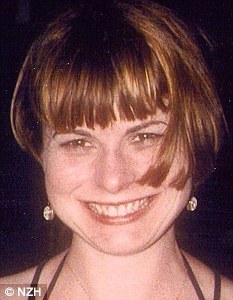
- Then there is the very curious and highly under-reported case of Richmal-Marie Oates-Whitehead, aged 35, who worked in a non-doctor role for a British Medical Association publication. She was in Tavistock Sqaure and was hailed as a hero for her brave actions during the crisis and her efforts to help people. But he young woman from New Zealand had insisted that she had heard two separate explosions on the No.30 bus and that the police had carried out a controlled explosion at Tavistock Square. The police and the corporate/state-controlled media angrily denied this and the woman from New Zealand who had, prior to this statement, been celebrated as a heroine was now suddenly being character-assassinated in the press, with various slur campaigns and false information about her life and behaviour. Ms Oates-Whitehead is a perfect example of how the mass media can be employed to destroy a person’s reputation in the blink-of-an-eye – in this case, it was to discredit her testimony. Ms Oates-Whitehead was soon found dead in her flat in Shepherds Bush. She was, however, not the only witness to report multiple explosions.
- And what about the death of Jean Charles de Menezes; the Brazilian electrician brutally murdered by ‘police’ (or so we were told) on a tube-train in Stockwell? Professor Michael Clarke, Professor of Defense Studies at King’s College London, went as far as to say that unless there had been a major change in policy it was likely that it was not the police who had carried out the public execution of the Brazilian electrician, but Special Forces: “You don’t shoot somebody five times if you think you might have made a mistake and may be able to arrest him. Even Special Branch and SO19 are not trained to do this sort of thing. It’s plausible that they were Special Forces or elements of Special Forces.”
- In the Ripple Effect film, the subject of Jean Charles de Menezes is also brought up; ‘Remember that the first reports from the media about 7/7/2005 were of an electrical power-surge, and Jean Charles de Menezes was a contract electrician. Was he hired, as part of the terrorist exercise… to wire up devices for mock-explosions, to be set off by a power-surge? Did he see the explosive-devices being fastened under the tube-train carriage floors, and later realise what had really happened, and was starting to talk about it?’ That’s just speculation, of course; but then the official story of what happened to Jean Charles de Menezes has changed so many times and been so inconsistent that such speculation is just as valid as any of the ‘official’ explanations. We are told (officially) that the killing of the Brazilian electrician was a case of mistaken identity, that his killers did what they did only “because he ran”, and that they were convinced he had a suicide-bomb strapped to him. This is all, however, an obvious cover-up to (unconvincingly) disguise the fact that it was simply an extra-judicial murder.

- Jean Charles de Menezes had committed no crime, and he was unarmed when he was shot multiple times in the head and at close-range and in full view of tube passengers. A finger is legitimately pointed at the Army’s Special Reconnaissance Regiment, which had been set up in April of 2005, only months before the London bombings. The behaviour of the Brazilian electrician’s killers suggests a powerful unit that considers itself above the law, more reminiscent of the Special Forces type ‘Death Squads’ that were sent to operate in, for example, Libya and Syria in 2011. It remains very possible, even likely, that Jean Charles de Menezes was chased and executed because he knew too much – and it is also possible his unlawful execution was intended as a brutal warning to anyone else who might’ve had knowledge of 7/7 and might’ve intended to go public (like, for example, the aforementioned and tragic Richmal Marie Oates-Whitehead, who died suddenly).
Additional curiosities;
- Along with Police Commissioner Ian Blair, the New York ‘9/11 Mayor’ Rudi Guliani, the soon-to-be Israeli Prime Minister Benjamin Netanyahu and the terror-drill supervisor Peter Power were all coincidentally in or around Central London and the London Underground locations where the explosions took place. For the record, Netanyahu was also in New York on the morning of 9/11. Why was Guliani in London on 7/7? Other than the vague explanation of “business”, no answer has been given. Was he part of Peter Power’s ‘terror drill’?
- Benjamin Netanyahu in fact told the media that he had been warned by Scotland Yard on the morning of 7/7 not to leave his hotel that morning: this being prior to any of the explosions occurring (funny how the visiting Israeli Minister was warned, but none of the innocent British citizens and commuters were given any warning not to get on those tube-trains). Scotland Yard denies having warned Netanyahu. A fortnight later, the head of the Israeli Mossad also claimed to have warned Netanyahu some six minutes before the first explosion. But how did the head of Mossad know the explosion was about to occur? Juval Aviv, ‘an international security expert’ (and former Mossad agent) even appeared to accidentally admit to Fox News that his agency were involved in the 7/7 attacks when he slipped up and referred to what “we did in London”.
- No one has ever claimed responsibility for the London bombings. Of course the first rule of terrorist organisations is to make sure they’ve claimed responsibility for an attack. But no one did for 7/7, except for one solitary claim on an ‘Al-Qaeda website’ that was soon declared fake and in fact traced to Texas.
- According to Sky News, the mastermind behind the July 7th London Bombings in 2005 was Haroon Rashid Aswat. Which is significant. Because according to former Justice Department prosecutor and terror expert, John Loftus, at the time of the 7/7 London bombings Haroon Rashid Aswat was “working for British Intelligence”. Suggestions persist too that the alleged leader of the 7/7 bombers, Mohammad Sidique Khan, was an MI5 contact (which wouldn’t be all too surprising if, as those who knew him say, he was a patriotic British citizen). According to a government report published in May 2009, in fact, at least two of the bombers had a prior relationship with MI5. French Interior Minister at the time of the bombings and future Libyan War Criminal Nicolas Sarkozy, told the press that at least two of the bombers had been arrested and released by the UK authorities in 2002. An embarrassed Charles Clarke, then British Home Secretary, simply responded that he was not “personally aware” of the arrests. Haroon Rashid Aswat, an Indian-born man living in Dewsbury, was claimed to be under the protection of MI6. He was known about as far back as 1999, when Seattle prosecutors wanted to prosecute him for terrorist activity, but were ordered by the US Justice Department to leave him alone because he was working for British Intelligence.
_______________________
There is of course more. More suspicious information, more curious details, other connections and theories. By all means, I encourage everyone do further research and examine the data.
And let none of this be seen to be getting in the way of or disrespecting the tributes that are being paid to the 52 people who were killed that day or the hundreds injured, traumatised or who had their lives changed. What those people have suffered or lost is a crime for which someone should some day be made to answer for. But when I consider the many victims of 7/7, I also include the 35 year-old Richmal-Marie Oates-Whitehead, whose mysterious death no one seemed to mourn (and indeed many in the media in fact mocked), and Jean Charles de Menezes and his unlawful execution.
And I also include Mohammad Sidique Khan, Hasib Hussain, Shehzad Tanweer and Germaine Lindsay, who not only lost their lives, but to this day are unequivocally regarded as murderers and terrorists – and will no doubt be referred to as murderers and terrorists frequently throughout today’s coverage.
There is the also the curious issue of a piece of legislation called the ‘Inquiries Act 2005’, which was passed into law precisely one month before 7/7. The act legislates full control of every aspect of any public inquiry, allowing the State to obstruct scrutiny of State actions, obstruct any avenues of inquiry, suppress publication of important information, and, as the July 7th Truth Campaign says, ‘a raft of other things that are counter to conducting an honest and open public inquiry.’ It was fantastic foresight, of course, that this act was passed into law just in time for the events of 7/7.
Tony Blair, who had only just narrowly won a General Election, was facing immense, growing pressure from British citizens to pull British forces out of the Bush/Neo-Con illegal (and morally bankrupt) War in Iraq (otherwise known as The War to Create ISIS), which was by then in its second year. 7/7 acted as the perfect excuse to continue the war in order to protect Britain from these terrible ‘Islamist terrorists’. The only problem is that there weren’t any Islamist terrorists on 7/7, merely mock-drill actors who’d been misled and then disposed of. Blair himself remarkably dismissed the early calls for an inquiry as a “ludicrous diversion”.
What 7/7 also accomplished was a shift in popular perception in Britain; a newly-reinforced belief that the ‘War On Terror’ was necessary and had to be continued.
It also, of course, added substantially to the ill-feeling or mistrust towards British Muslims that continues to this day, and at the same time caused many, many British Muslims to retreat into a siege mentality. This is particularly significant in light of the fact that a very high percentage of British Muslims don’t believe the four 7/7 ‘bombers’ were guilty of the crime; and are therefore now highly suspicious of British intelligence and security services and the police and so much more unlikely to willingly cooperate with authorities.
Today you will hear various commentators say that 7/7 was a ‘turning point’ for the country. It was; both for the dozens of people who were killed or lost their loved ones, and for the hundreds terribly injured, and it was too for the many, many British Muslims who have lived in that event’s shadow ever since. It was also a turning point for the march towards a Police State, the diminishing of civil liberties, the ability (and justification) of the government and intelligence agencies to spy on its citizens and intrude into people’s private lives and data, and for the escalation of the ‘War On Terror’ and all the various subverting of law, justice and principles that this ill-defined ‘war’ has entailed.
Some of you might, even now, still be sceptical of the idea that 7/7 was an Inside Job and might prefer to continue blaming four dead young men who can’t speak any longer. That’s fine. But bear in mind that the British state, terrorism, cover-ups and miscarriages of justice aren’t some new, shocking phenomenon. The State and the police colluded in false convictions, destruction or suppression of evidence and in long-term cover-ups plenty of times before 7/7. Ever heard of the ‘Birmingham Six’? Or the Guildford Four? The Maguire Seven? Ever heard of something called Lockerbie? Abdel Basset al-Magrahi sat in a Scottish prison for years, eventually dying of cancer, for a crime it is fairly clear he didn’t commit; whoever did carry out Lockerbie, it was clearly aimed at bringing about the collapse of Libya via the subsequent economic sanctions and ‘pariah state’ status, just as 7/7 was aimed at continuing to bring about the collapse of Iraq.
And staying on the matter of Libya, that brings us to what is a very curious epilogue to this piece.
Woman Police Constable (WPC) Yvonne Fletcher was a British policewoman who was shot and killed in London’s St James’s Square during a protest outside the Libyan embassy; it was in 1984. The shooting resulted in a siege at the embassy which lasted for eleven days, as well as the breakdown of diplomatic relations between the United Kingdom and Gaddafi’s Libya.
In 1996, 12 years after the killing, the Channel 4 documentary programme Dispatches, in what was acknowledged by all to have been a massively researched and extremely credible work of broadcast journalism, cited various credible and experienced sources to conclude that Fletcher had in fact been murdered by elements of British and American intelligence. Although the mainstream, corporate-owned media observed a complete blackout on the Dispatches story, the problems raised by the programme about the killing of WPC Fletcher were later brought up in Parliament by MP Tam Dalyell (on the 8th May 1996). Mr Dalyell told Parliament that the programme had been exceptionally well researched and that it had featured statements from people whose calibre and relevant experience was beyond question; this had included a senior ballistics officer in the British Army, Lieutenant Colonel George Styles, and a distinguished Home Office pathologist. Dalyell raised several key issues in relation to the murder of WPC Fletcher, including the fact that the policewoman appeared to have have been shot from a different direction than reported, that highly significant discrepancies existed in the pathologist’s reports, and that Fletcher’s fatal injuries could not have been caused by the alleged combination of gun and firing position.
The results of the immediate investigation into Yvonne Fletcher’s murder have never been divulged to the public and have remained one of Britain’s numerous State secrets. But to highlight how important the shooting of Ms Fletcher was, in 1998, 14 years after her killing, it was still being cited as the sole reason by Jack Straw for maintaining the ongoing sanctions against the Socialist Republic of Libya. The incident was in fact a major ‘justification’ cited by Margaret Thatcher to support and enable America’s 1986 bombing of Libya (in which some fifty or so Libyan civilians, including Gaddafi’s adopted daughter, were killed).
The reason I bring all of that up here is this; the deputy forward controller at the Libyan People’s Bureau siege at which WPC Yvonne Fletcher was shot was none other than Mr Peter Power; the man most associated with the astonishingly coincidental ‘terror drill’ of 7/7.
It just goes to show that, as they say, ‘what’s past is also prologue’.
If a true, genuine inquest into the shooting of Yvonne Fletcher or into the Lockerbie bombing had ever been allowed to be conducted, it would’ve made a major difference to the course of subsequent events regarding Libya, regarding even the advent of Al-Qaeda and the spread of terrorism (both of which Gaddafi had been trying to curtail as far back as 1996 when MI6 had hired Al-Qaeda to try to assassinate him). Likewise, if a true, genuine inquest into the events of 7/7 was ever conducted, it could reverse much (though not all) of the negative consequences that came after that day.
Which is why it won’t happen. In October 2010 an independent coroner’s inquest of the bombings began. Lady Justice Hallett, appointed to hear the inquest, decided that there should be no public inquiry.
Predictably, there are going to be people on social networks who attack anyone who questions the official 7/7 narrative; it has happened to me a number of times already, in which I’ve been accused of ‘dishonouring’ or ‘disrespecting’ the victims by ‘promoting conspiracy theories’.
Anyone who shares that view is, frankly, stupid. Because it seems more logical to suggest that what really ‘dishonours’ the victims is to continue to blindly uphold what is an obviously false narrative concerning their deaths. Surely the way to ‘honour’ those deaths or traumas is to try to establish the true version of how they died, why it happened and who was responsible for it?
It is surely no disrespect or ‘dishonouring’ of those victims to wish to get closer to the truth of what happened.
London is my city too; I am as invested in its safety as anyone else. I had three friends and one relative caught up in those tube explosions and the chaos of that morning, and Mr George Paradakis, the driver of the No.30 bus that exploded in Tavistock Square, is the father of a family friend; and I could’ve easily been on one of those tube-trains myself.
So could any one of us.
The (official) Home Office Report concerning the 7/7 bombings can be read here.
The best, most comprehensive on-line resource on the subject of the 7/7 bombing is the July 7th Truth Campaign here.


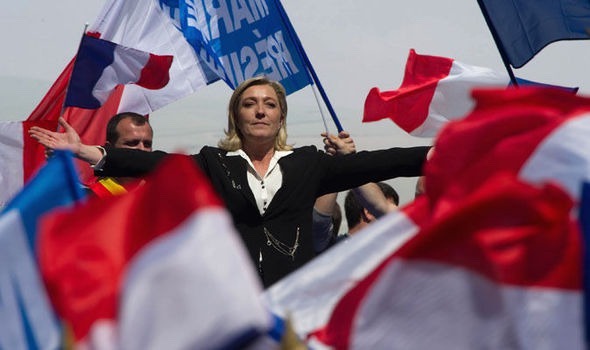
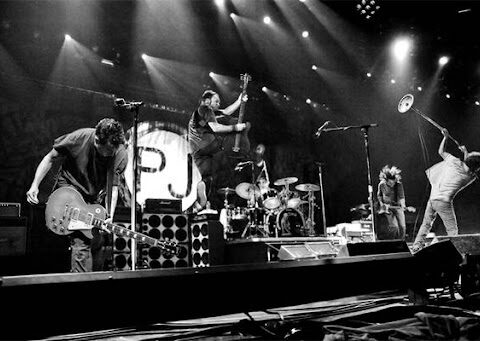

Has anyone noticed the jaguar. It may be coincidence but look at the photo of the blown up busfirst on this blog. The car behind the bus is a black jaguar. Just happens to be the same tyoe and colour as the jaguar which was seen on video at luton Station and the cctv cuts off just as it approaches the “bombers” car.
That’s interesting: i never noticed that before. Could it be the four boys’ ‘handlers’ or instructors?
Im going to make a suggestion here that no ome has looked at. Professor Judy wood was demonised during 911 for her evidence of dew weapons. I feel the 77 event 8s the same. No explosive residue. Mangled metal twisted and rolled. I see clear holes in the metal like swiss cheese at points. I have a photo which has been blurred on a vital puece of metal on the bus. Everyone reported a white light and feeling electrocuted. The electrician was murdered “accidentally”. Power surges were reported. All of which are entirely consistent with dew weapons. Lockheed martin show dew weapons tested on a car on their website. Go take a look. It may also explain why some people were killed and others walked away. The energy is directed so depending where u are ubwill not be affected. No trace can be found afterwards in chemical tests because its light or microwave technology used. If it came through the floor then easy to be installed on tracks etc. Although they clearly didnt expect when they powered ot up to cause the power surges they did
Just reading now, 13 Nov 2018. Well put together. Well written. Thank you. I shall pass this on.
Just happened across your site from a reference elsewhere to the Robin Cooke anniversary. Had to read the 7/7 stuff which I already knew, but wanted to say great work. I’ll pass your link on as often as I can. Keep it up fella.
Thank you for putting this information together
Reblogged this on TheFlippinTruth.
The human memory is not that good you know.
Anything could have happened. We do not know. WE were not there.
Never the less…. this war continues.
Quite an exhaustive post here! Well done. Best overview of 7/7 I’ve found since listening to Tom Secker. ( http://themindrenewed.com/interviews/708-int-38repost )
Thanks man. And thanks for the link, I’m listening to it right now.
Now there you have it. All the information but no coverage. Gee, Tubularsock wonders who did it.
All of these events are investigated with their eyes closed and if it is extremely bad a blind Blue Ribbon Committee. That is when you know the lie has to be deep-sixed!
Reblogged this on News for the Revolution.